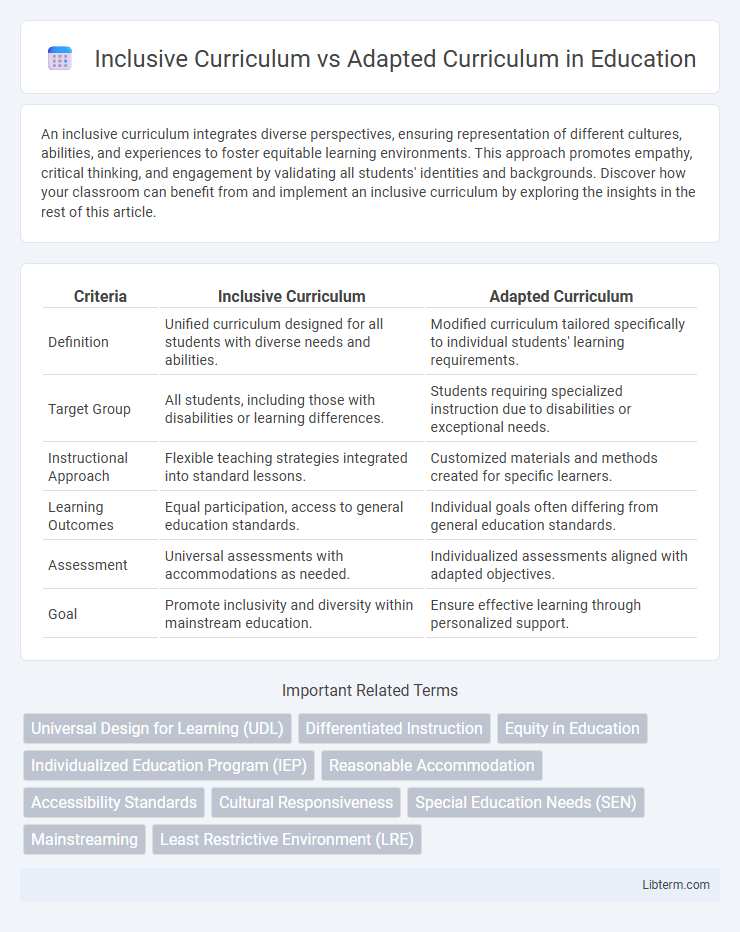An inclusive curriculum integrates diverse perspectives, ensuring representation of different cultures, abilities, and experiences to foster equitable learning environments. This approach promotes empathy, critical thinking, and engagement by validating all students' identities and backgrounds. Discover how your classroom can benefit from and implement an inclusive curriculum by exploring the insights in the rest of this article.
Table of Comparison
| Criteria | Inclusive Curriculum | Adapted Curriculum |
|---|---|---|
| Definition | Unified curriculum designed for all students with diverse needs and abilities. | Modified curriculum tailored specifically to individual students' learning requirements. |
| Target Group | All students, including those with disabilities or learning differences. | Students requiring specialized instruction due to disabilities or exceptional needs. |
| Instructional Approach | Flexible teaching strategies integrated into standard lessons. | Customized materials and methods created for specific learners. |
| Learning Outcomes | Equal participation, access to general education standards. | Individual goals often differing from general education standards. |
| Assessment | Universal assessments with accommodations as needed. | Individualized assessments aligned with adapted objectives. |
| Goal | Promote inclusivity and diversity within mainstream education. | Ensure effective learning through personalized support. |
Introduction to Inclusive and Adapted Curricula
Inclusive curriculum integrates diverse learners by providing equitable access to standard educational content, ensuring all students engage with the same core material through differentiated instruction. Adapted curriculum modifies content, objectives, or learning outcomes to meet the unique needs of students with disabilities or learning challenges, often simplifying or altering expectations. Both approaches aim to support student success but differ fundamentally in the degree of content alteration and instructional strategy.
Defining Inclusive Curriculum
An inclusive curriculum integrates diverse perspectives, learning styles, and abilities within the standard educational framework to ensure all students participate fully and equitably. It emphasizes universal design principles, promoting accessibility and representation for learners from various backgrounds without segregating or modifying content solely based on disability or learning differences. Inclusive curriculum fosters an environment where diversity informs teaching methods and materials, supporting equity and belonging for every student.
Understanding Adapted Curriculum
Adapted curriculum involves modifying learning materials, teaching methods, and assessment techniques to meet the diverse needs of students with disabilities or learning challenges. This tailored approach ensures accessibility to the core content while addressing individual abilities, promoting meaningful participation and academic success. Understanding adapted curriculum requires recognizing its role in providing equitable educational opportunities by accommodating specific learning differences without altering overall educational standards.
Core Principles of Inclusion in Education
Inclusive curriculum emphasizes universal design to accommodate diverse learners within the same classroom, promoting equity and access by integrating all students regardless of abilities or backgrounds. Adapted curriculum modifies content, delivery, and assessment specifically for students with special needs, ensuring individualized support while maintaining alignment with educational standards. Core principles of inclusion prioritize respect for diversity, equal opportunities, and collaboration among educators, families, and students to foster a supportive learning environment.
Key Features of Adapted Curriculum
Adapted curriculum emphasizes personalized learning goals tailored to individual student needs, often modifying content, process, or product to accommodate diverse abilities. Key features include differentiated instruction, flexible pacing, and specialized assessment methods designed to support students with disabilities or learning challenges. This approach ensures equitable access to education by addressing specific barriers and fostering skill development aligned with each learner's potential.
Benefits of an Inclusive Curriculum
An inclusive curriculum promotes diversity by integrating students with varying abilities and backgrounds into the same learning environment, fostering collaboration and mutual respect. It supports social development and reduces stigmatization often associated with specialized adaptations. Research shows that students in inclusive settings demonstrate improved academic outcomes and enhanced empathy compared to those in adapted curricula.
Challenges of Implementing Adapted Curriculum
Implementing an adapted curriculum presents challenges such as limited teacher training and resource availability, which can hinder effective customization for diverse learner needs. Schools often struggle with balancing curriculum standards and individualized content, leading to inconsistencies in student assessment and progress tracking. Furthermore, integrating adapted curriculum methods requires ongoing collaboration between educators, specialists, and families to ensure alignment and maximize student success.
Comparative Analysis: Inclusive vs Adapted Approaches
Inclusive curriculum integrates diverse student needs within a unified learning environment, promoting equal access and participation for all learners by modifying teaching methods and materials to suit varied abilities. Adapted curriculum involves tailoring specific content and learning objectives to meet individual student requirements, often creating separate or specialized instructional plans. Comparative analysis reveals that inclusive approaches foster social integration and collaboration, while adapted curricula emphasize personalized learning outcomes and targeted support for distinct disabilities or challenges.
Best Practices for Curriculum Development
Best practices for curriculum development emphasize designing inclusive curricula that integrate diverse perspectives and learning needs within a unified framework, promoting equity and accessibility for all students. Adapted curriculum involves modifying existing content and instructional strategies to accommodate specific learners, particularly those with special education needs, ensuring personalized support and skill mastery. Combining universal design for learning principles with ongoing assessment and collaboration among educators fosters effective implementation of both inclusive and adapted curricula, enhancing student engagement and achievement.
Future Trends in Curriculum Design for Diverse Learners
Future trends in curriculum design emphasize creating an Inclusive Curriculum that integrates diverse learners by embedding universal design principles and culturally responsive teaching strategies. Adapted Curriculum, which modifies content to meet individual needs, remains essential for providing personalized learning pathways, particularly for students with disabilities. Increasing use of technology-driven adaptive learning platforms is expected to blend both approaches, promoting accessibility while maintaining academic rigor for all students.
Inclusive Curriculum Infographic

 libterm.com
libterm.com